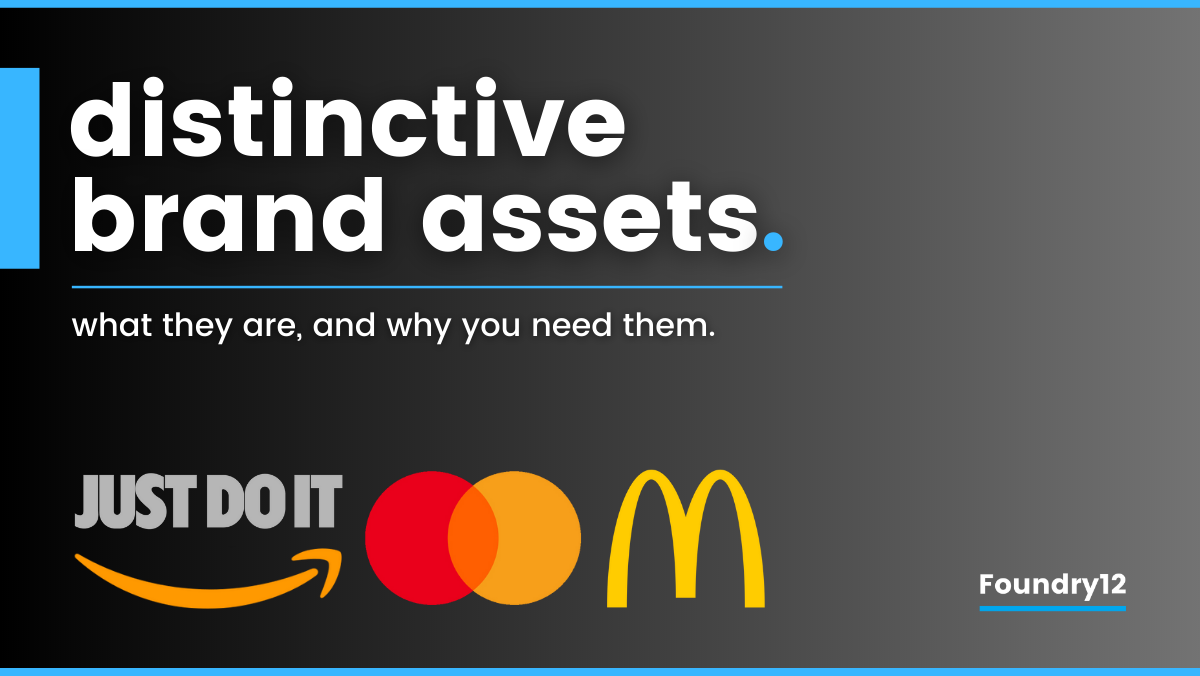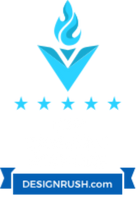Distinctive brand assets are powerful tools your business needs. That’s what.
They’re something you can own, no one else. Which, when you’re fighting hard to get your brand noticed, considered, chosen, makes them pretty huge things to have at your disposal. Particularly so if you’re in a homogenous or highly competitive market.
And they only work harder for you over time, that’s what’s so great about them. Apply them consistently across all your marketing and advertising and they cunningly go about their business helping your brand more easily and more quickly get inside the minds of all those people you want to attract and turn into customers.
They elevate your brand above your competition. They ensure you aren’t just wallpaper no-one notices. They make you memorable, get you there ahead of your competition, and help you win. Not a bad thing to have, are they?
So there you go, that’s the answer. You can leave now.
Or at least that’s the short answer. But if you wander off now, do you really know why? Do you know what they are and what you need to do to create distinctive brand assets of your own?
Why not stay a little bit longer and find out.
A bit of context
We live and work in an information overload, multi-channel, noisy world. On a daily basis our senses are bombarded with so much information it’s impossible to take in even a fraction of what we’re exposed to.
And every business, your business, is fighting to cut through all that noise. Trying to make your brand recognisable, memorable and chosen. Just look at these two stats to see why achieving that is such a challenge:
- 75% of users cannot remember the content or brand following exposure to it just the previous day. Nielsen (2018)
- Only 4% of digital ads get looked at for 1 second or more. Lumen (2018)
Pile on top of that today’s challenging economic landscape, when less customers are out there actively looking for the product or service that meets their needs or solves their problem, with less available money to spend, and you need to compete even harder for every customer.
To help you win you need an edge, you need something that helps you get ahead of your competitors, establishing memory structures and mental associations in the minds of your target market.
You need distinctive brand assets.
Because creating a brand that stands out from the competition is crucial in attracting and retaining customers.
Understanding Distinctive Brand Assets
To kick off let’s define what a distinctive brand asset is.
“A distinctive brand asset is an identifiable visual, verbal or audible element that acts as a trigger, allowing people to form mental associations which quickly and easily identify a brand, across all touchpoints.”
Distinctive brand assets are central to creating a strong and lasting impression because they improve brand recognition, build brand equity, and aid recall. All rather helpful when it comes to getting your product or service ‘on the mental shortlist’, influencing preference and enhancing the probability of purchase. And boosting business growth.
Types of Distinctive Brand Assets
When looking at your brand, and its attributes, there are three broad types of distinctive assets you can leverage to create a unique, recognisable, and memorable identity:
- Visual – your logo, font, a particular colour scheme, a unique design element or pattern.
- Verbal – slogans or taglines.
- Audible – a specific sound or jingle.
Whatever type (or combination) a brand uses, to be effective these assets should be easily identifiable. And when applied consistently across all touchpoints, they become something your brand ‘owns’.
Successful Distinctive Brand Assets
OK, so there are three broad types, but understanding good examples would help wouldn’t it. So here you go, some powerful and iconic examples for you:
- Coca-Cola’s signature red and white colour scheme and their iconic bottle shape.
- Mastercard’s red and yellow overlapping circles.
- Nike’s swoosh or ‘Just Do It’ slogan
- Guinness’s four fifths black, one fifth white colour combination. And their golden harp.
Other businesses have successfully leverage distinctive sounds. Take the Intel chime for example. The sound of the Intel chime is instantly recognisable and intrinsically linked to the brand.
Another example of a brand successfully maxing out on a distinctive brand asset is McDonald’s and its golden arches. The arches are so recognisable today they don’t need the McDonald’s name to be present for advertising to be associated with the brand.
They’re so established and strongly embedded in our psyche (thanks to consistent use) that McDonald’s has the confidence to have fun with them. Seen any of their directional Out Of Home activity? If you haven’t you must have seen the ‘raised eyebrows’ TV ad. How strong was that? It’s testament to the power of a consistently applied brand asset that you didn’t see the brand anywhere but still knew it was a MaccyD’s ad.
Hat’s off to them. There’s a distinctive brand asset if ever there was one.
The Importance of Distinctive Brand Assets in Business Success
Ultimately, the goal of a distinctive brand asset is to create a strong and lasting impression. Leverage them effectively, and businesses can establish a unique and memorable brand identity that sets them apart from their competitors, building mental availability in the minds of their target market.
As the unique and ownable cues that customers associate with a brand, they can impact a business’s growth in several ways:
Increasing Brand Recognition
A distinctive brand asset helps a business stand out from its competitors in a crowded market. Both ‘on the shelf’ and in the mind. When customers repeatedly see a business’s logo or other visual element, they form mental shortcuts, quickly associating those elements with the brand. Over time, consistent exposure to the brand assets and subsequent mental association increases brand recognition.
This in turn helps cultivate a sense of familiarity and trust. When customers or target audiences are frequently exposed to the consistent use of a recognisable logo or design element, or hear a familiar jingle, they’re more likely to perceive the brand as reliable and established.
So when it’s time to purchase a product or service, those brands that are recalled first have a greater probability of being purchased.
“Advertising featuring known distinctive brand assets achieved an average +34% higher advertising recognition in a study by Jenni Romaniuk at the Ehrenberg-Bass Institute.”
Remember, the first search engine any of us uses isn’t google or bing, it’s our own memory.
Building Brand Equity
Brand equity is the financial premium a business can generate through a recognisable and established brand, over and above less well recognised competitors. It’s the commercial value derived from customer perception of the brand rather than the product or service itself. And it translates to a significant impact on the bottom line.
Distinctive brand assets build brand equity. Coca-Cola’s distinctive and synonymous red and white logo and classic script font helped them become one of the most valuable brands in the world. In 2021 their brand equity was calculated to be US$87.6 billion (source: Statista).
Differentiating from Competitors
Creating a recognisable point of difference is integral to helping a business carve out a position for itself that:
- communicates the value it offers,
- attracts new customers,
- builds a loyal customer base.
When customers are loyal to a brand, they’re more likely to make repeat purchases based on the perceived value they derive, and less likely to switch to a competitor. Something important right now in the current challenging market.
And whilst defending your position is the first objective, repeat purchase from a static customer base isn’t the road to future growth. Widening reach and acquiring new customers is.
By leveraging your own distinctive assets effectively, you can establish a unique and memorable brand identity that sets you apart from your competitors. And build mental availability in the minds of your customers and target audience so when they’re in market, yours is the product or service that stands out. Leading to future sales.
Developing Your Own Distinctive Brand Assets
So if you think ‘we need a bit of this, why haven’t we created our own distinctive brand assets already’, there are some steps you need to take to get started.
Identify Your Brand’s Unique Characteristics
Before you can create distinctive brand assets, you need to understand what makes your brand unique. To get there you should consider:
- your brand values that shape how you act,
- your target audience and their needs and pain points,
- the products or services you offer and how they provide the solutions your target audience need.
This should help you unearth what is it that sets your business apart from others in your industry. Once you have a clear understanding of your brand’s unique characteristics, you can begin to craft visual and messaging elements that align with your brand identity.
Create Memorable Visuals and Messaging
To create distinctive brand assets, prioritize creativity and originality. Your visuals and messaging need to grab attention, embed themselves in the minds of your target market and last long in the memory.
Brand elements like your colour, font, and style of imagery or illustration need to combine to create a look and feel that’s unmistakably yours. And together with a tone of voice that carves out your position through messaging elements like taglines, slogans and copy, they need to be the embodiment of what your brand is.
To stand out and be memorable, you need to be brave in your approach and have a clear point of view that resonates. Playing it safe or copying the market leader isn’t going to help you create distinctive brand assets.
Apply Consistently Across All Marketing Channels
All the stuff about creativity, originality, distinctiveness, it’s all undermined if you fail to apply your distinctive assets consistently. Consistency is key when it comes to building the strong distinctive brand assets that help people instantly recognise you.
Ensure that all your assets are consistent across all marketing channels. Use your visual and messaging elements consistently in all you offline and online marketing and advertising, your business collateral and all your communications for maximum impact. This effective and consistent leveraging reinforces your brand identity and makes it easier for your target market to remember your business, boosting brand recognition and equity.
Evaluate Regularly and Update If Needed
It’s essential to regularly evaluate and update your distinctive brand assets to ensure they still resonate with your target audience. As your business grows and evolves, your brand assets will potentially need to evolve too. Don’t be afraid to make changes if regular evaluation tells you they’re no longer serving your business’s needs or those of your customers.
What makes for an effective asset?
Here are some of the main questions to ask when evaluating if a distinctive brand asset is effective.
- Is it easily recognised?
Is it clearly linked to your brand? - Is it useable across touchpoints?
- Is it useable for many years?
Is it creatively flexible?
To sum up then…
Distinctive brand assets are essential for any business looking to stand out from their competitors or improve their position in a crowded marketplace. And should be a critical component of a successful business strategy.
By developing and consistently applying visual, verbal or audible cues that people associate with the brand, businesses can increase brand recognition, build brand equity, differentiate from competitors, and enhance customer loyalty. By investing time and resources in creating ownable brand assets, businesses can set themselves up for long-term success and growth.
Shall we?
If you want to identify your brand’s unique characteristics, or create distinctive brand assets that make sure your brand is your competitive advantage, we’ll go through the process with you step by step. It just starts with a chat.
________________
If you found that interesting, here’s another related post you might also be interested in:




